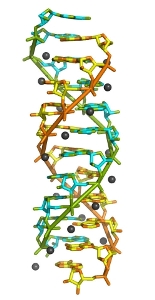Aug 27 2013
When Francis Crick and James Watson discovered the double helical structure of deoxyribonucleic acid (DNA) in 1953, their findings began a genetic revolution to map, study, and sequence the building blocks of living organisms.
 Structure of poly (rA) duplex showing the two strands in orange/yellow and green/blue. Ammonium ions that stabilize the structure are shown as black balls. Credit: Kathryn Janzen, Canadian Light Source
Structure of poly (rA) duplex showing the two strands in orange/yellow and green/blue. Ammonium ions that stabilize the structure are shown as black balls. Credit: Kathryn Janzen, Canadian Light Source
DNA encodes the genetic material passed on from generation to generation. For the information encoded in the DNA to be made into the proteins and enzymes necessary for life, ribonucleic acid (RNA), single-stranded genetic material found in the ribosomes of cells, serves as intermediary. Although usually single-stranded, some RNA sequences have the ability to form a double helix, much like DNA.
In 1961, Alexander Rich along with David Davies, Watson, and Crick, hypothesized that the RNA known as poly (rA) could form a parallel-stranded double helix.
Fifty years later, scientists from McGill University successfully crystallized a short RNA sequence, poly (rA)11, and used data collected at the Canadian Light Source (CLS) and the Cornell High Energy Synchrotron to confirm the hypothesis of a poly (rA) double-helix.
The detailed 3D structure of poly (rA)11 was published by the laboratory of McGill Biochemistry professor Kalle Gehring, in collaboration with George Sheldrick, University of Göttingen, and Christopher Wilds, Concordia University. Wilds and Gehring are members of the Quebec structural biology association GRASP. The paper appeared in the journal Angewandte Chemie International Edition under the title of “Structure of the Parallel Duplex of Poly (A) RNA: Evaluation of a 50 year-Old Prediction.”
“After 50 years of study, the identification of a novel nucleic acid structure is very rare. So when we came across the unusual crystals of poly (rA), we jumped on it,” said Dr. Gehring, who also directs the McGill Bionanomachines training program.
Gehring said identifying the double-helical RNA will have interesting applications for research in biological nanomaterials and supramolecular chemistry. Nucleic acids have astounding properties of self-recognition and their use as a building material opens new possibilities for the fabrication of bionanomachines – nanoscale devices created using synthetic biology.
“Bionanomachines are advantageous because of their extremely small size, low production cost, and the ease of modification,” said Gehring. “Many bionanomachines already affect our everyday lives as enzymes, sensors, biomaterials, and medical therapeutics.”
Gehring added that proof of the RNA double helix may have diverse downstream benefits for the medical treatments and cures for diseases like AIDS, or even to help regenerate biological tissues.
“Our discovery of the poly (rA) structure highlights the importance of basic research. We were looking for information about how cells turn mRNA into protein but we ended up answering a long-standing question from supramolecular chemistry.”
For the experiments, Gehring and a team of researchers used data obtained at the CLS Canadian Macromolecular Crystallography Facility (CMCF) to successfully solve the structure of poly (rA)11 RNA.
CMCF Beamline Scientist Michel Fodje said the experiments were very successful in identifying the structure of the RNA and may have consequences for how genetic information is stored in cells.
“Although DNA and RNA both carry genetic information, there are quite a few differences between them,” said Dr. Fodje. “mRNA molecules have poly (rA) tails, which are chemically identical to the molecules in the crystal. The poly (rA) structure may be physiologically important, especially under conditions where there is a high local concentration of mRNA. This can happen where cells are stressed and mRNA becomes concentrated in granules within cells.”
With this information, researchers will continue to map the diverse structures of RNA and their roles in the design of novel bionanomachines and in cells during times of stress.
Research on the poly (rA) structure was funded by grants from the Natural Sciences and Engineering Research Council of Canada with support from the Canada Foundation for Innovation, the Government of Quebec, Concordia University, and McGill University.
The Canadian Light Source, located on the University of Saskatchewan campus in Saskatoon, is Canada’s national centre for synchrotron research. CLS operations are funded by the Canada Foundation for Innovation, the Natural Sciences and Engineering Research Council, Western Economic Diversification Canada, the National Research Council of Canada, the Canadian Institutes of Health Research, the Government of Saskatchewan and the University of Saskatchewan.
Link to the paper: Safaee, N., Noronha, A. M., Rodionov, D., Kozlov, G., Wilds, C. J., Sheldrick, G. M., & Gehring, K. (2013). Structure of the Parallel Duplex of Poly (A) RNA: Evaluation of a 50 Year‐Old Prediction. Angewandte Chemie International Edition.